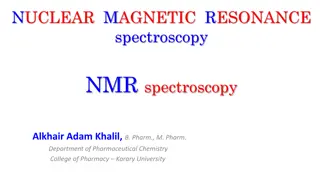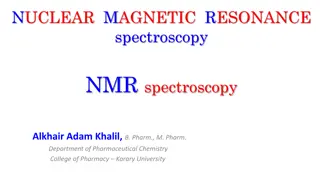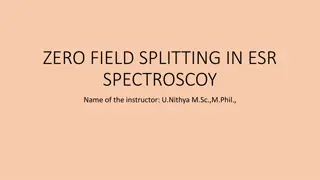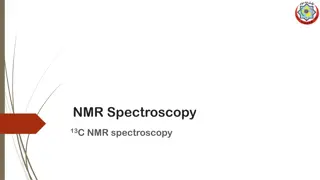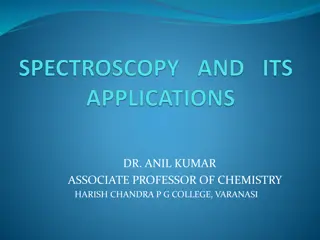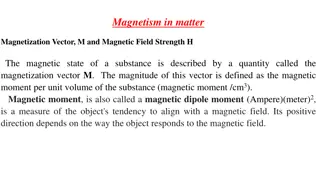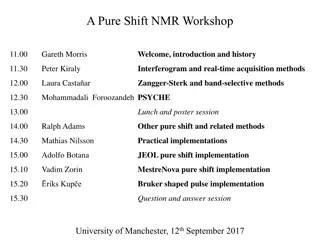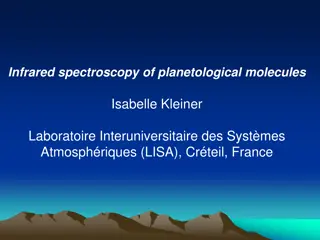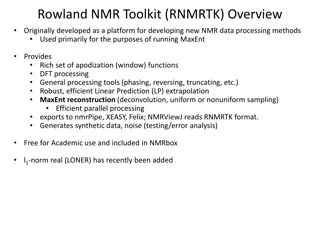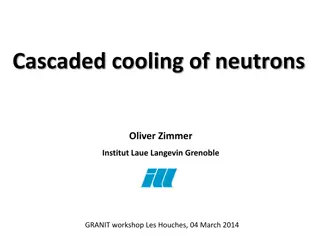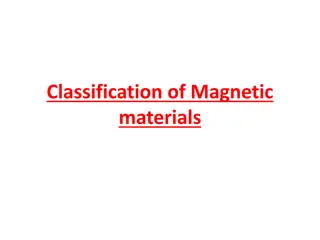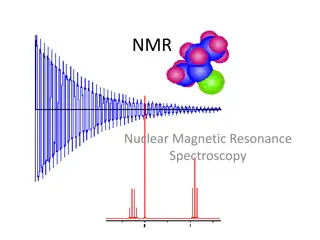Understanding NMR Spectroscopy of Paramagnetic Molecules
NMR spectroscopy of paramagnetic molecules is influenced by the presence of unpaired electrons, leading to broadened spectra and complex coupling mechanisms. Quadrupolar nuclei, with spins greater than 1/2, play a significant role in the relaxation and splitting of NMR signals. The interaction between the quadrupolar nucleus and the electric field gradient impacts the spectral characteristics. Additionally, the spectrum varies based on the geometries and electron distributions in compounds. The discussion covers the challenges and insights offered by NMR spectroscopy in studying paramagnetic compounds.
- NMR Spectroscopy
- Paramagnetic Molecules
- Quadrupolar Nuclei
- Electric Field Gradient
- Spectral Analysis
Download Presentation

Please find below an Image/Link to download the presentation.
The content on the website is provided AS IS for your information and personal use only. It may not be sold, licensed, or shared on other websites without obtaining consent from the author. Download presentation by click this link. If you encounter any issues during the download, it is possible that the publisher has removed the file from their server.
E N D
Presentation Transcript
NMR OF PARAMAGNETIC MOLECULES NAME OF THE INSTRUCTOR: U.NITHYA M.SC., M.PHIL.,
Effect off quadrupolar nuclei on 1H NMR spectra: Quadrupolar nuclei are those with spin greater than . A spin of causes a splitting into (n+1) lines. Quadruolar nuclei are very efficiently relaxed by the flutuating electric fields. The relaxation mechanism depends Upon the interaction of the quadrupolar nucleus with the electric field gradient (efg) at the nucleus. The efg is used to describe the deviation of the electronic charge cloud about yhe nucleus from spheriical symmetry. The gradient is zero for regular tetrahetral,octahetral,cubic or spherical symmetry. For other geometries the efg is not zero.
The quatrupolar nuclei have short relaxation times. The time depends upon the magnitude of the efg. The splitting of proton from the quadrupolar nucleus may not observed. Rapid quadruole relaxation places the proton on a nucleus whose spin state is rapidly changing.. As a result broading of the lines is observed. The proton nmr spectrum of 14NH3( 14N (I =1) consists of three broad Signals (2x1x1+1).
In the absence of the shift the spectrum of 15NH3( 15N I = ) consists of a sharp doublet ( 2x1x1/2 +1). In a molecule with a very large field gradient a broad signal with no fine structure. The most of the halogens no spectrum is obtained due to rapid relaxation. Very sharp signals obtained for the halide ions and. Symmetrical comounds. where the spherical charge distribution gives rise to very small efg and larger relaxatiin time. coupling to more than one quadrupolar nucleus is rarely observed. Expection is dueterium with I = 1 14NH4+has a spherical distribution of eletron density and hence the efg is zero.
NMR SPECTRUM OF PARAMAGNETIC MOLECULES: The NMR spectrum of many paramagnetic compounds can not be obtained because the unpairedelectrons broden the spectrum by both dipolar and electron spin nuclear spin coupling mechanisms. The normal chemical shift scale to more than 200 ppm for protons. The signals from diamagnetic materials may also show these effects in the presence of paramagnetic species even in low concentration. Eg. 31P Spectrum of Ru2Cl4( CO) (PPh3) 4
It shows two (AB) pattern signals arising from the four chemically non-equivalent triphenyl phophine ligands in the diamagnetic ruthenium complex. It undergoes a one eletron oxidation to give a cation in which the unpaired electron is localized on one ruthenium atom. This shifts the 31 P spectrum to nearly 80ppm and it is also very broad. The coupling pattern cannot be understood from broad peak. The spectrum of the other (AB) pattern is unchanged. The magnetic moment of an electron is 1000 times larger than nuclear magnetic moment. The life time of the electron spin state necessary to permit observation of nmr spectrum ranges from 10-9to 10 -13 s .
The rapid nuclear relaxation causes a broad nmr line but the rapid electron relaxation decreases the efficiency of the nuclear relaxation mechanism lengthening life time for proton nucleus and causing the line to sharpen. For Mn (II) complex a single very broad line is obtained because the electrons relax slowly. complex with triply degenerate (T) ground states have short electron Spin life times leading to sharp nmr spectra. Eg: octahedral complex Of d1,d2,low spin d4,low spin d5,high spin d6,highspin d7. Systems with broad nmr lines include octahedral d3,high spin d5and d9 configuration.
The paramagnetic shifts can be used to derive important information and are made up of two components. first there is a through space dipolar interaction between the magnetic moments of the electron and the resonating nucleus. It gives a dipolar shift or pseudo contact shift second the contact shift arises due to Coupling between electron and nucleus which would give a doublet under conditions of slow electron spin-lattice relaxation. contact sjifts give a measure of unpaired spin density at the resonating nucleus. Therefore they are useful in studying the spin distribution in organic radicals or in ligands in organometallic compounds.
Paramagnetic Compounds are used to induce decoupling by rapid relaxation mechanism. They are also used to eliminate the nuclear overhauser effect. shift in resonance frequency caused by paramagnetic substances can be used to measure the magnetic susceptibilities. The mass susceptibility Of the dissoved substance is given by
ISOTROPIC SHIFT:- A large. Chemical shift is observed for paramagnetic complex compared to the diamagnetic complex of the same ligand. The shift difference between the paramagnetic complex and an analogous diamalgnetic complex is referred to as the isotropic shift. Each spin may have a chemical shift value but a weighted average of the mole fraction of these two shifts would be observed when the spins are rapidly relaxing It is called average electron spin polarization Sq . Isotropic shift has two components 1) contact shift or scalar shift ii) Pseudo conduct shift or dipolar shift
Isotropic shift is used in the structure determination of complexes with the help of enhanced signal separation for paramagnetic complexes. Eg. Five coordinate schiff s base of Ni (II) It is also used to study the presence of ion pairs in solution nature of second co ordination sphere in complexes and yo study the equilibrium constant and the rate of chemical reactions. CONTACT SHIFT: contact shift occur in NMR spectrum for the paramagnetic molecules It arises due to the intraction of delocalized unpaired electron spin density onto the nmr nucleus It is otherwise called as scalar shift.
It is expressed in terms of the eletron spin nuclear spin coupling constant A. A value gives a very high isotropic shift. The major effect on the spectrum due to presence of unpaired electrons is to change the magnetic field experienced by the Magnetic nucleus This causes a very large chemical shift of the resonance. This shift is reffered to as contact shift. The relation between contact shift change and the electron spin nuclear spin coupling constant A is given as
Thus the nmr experiments are used to detect the unpaired spin density at the nucleus. eg. Contact shift values of metallocenes PSEUDO CONTACT SHIFT: It is otherwise called dipolar shift. Dipolar effect is averaged to zero by a rapid rotation of the molecule. g has different values for different orientations this through space contribution need not be averaged to zero by rapid rotation of the molecule.
Perfect cubic symmetry no pseudo contact contribution The psedo conduct contribution can be calculated for systems which have same known geometry in both solid state and in solution. The psedo contact term may also be calculated if the gtensor is known for the system under study. Pyridine N-oxide ligand has only pseudo conduct contribution. Isotropic shifts occurs when there is influence of solvent on ion pair. Non anisotropic tetrahedral metal containing anions can produce a pseudo contact contribution in a non-metallic cation.
LANTHANIDE SHIFT REAGENTS: The proton shifts lie in the range of 10 ppm It is very narrow compared to the chemical shift value of other elements for which thr normal ranges are hundreds of ppm. Therefore in proton spectrum Overlapping of lines may takes place. The spectral complexity arises due to small relative chemical shifts. This may be removed by adding a amount of a paramagnetic shift reagent. This will induce large differential shifts for the various types of protons present and spread out the spectrum
The rare-earth tris chelates of -- -6P diketonate derivatives are lewis acids and cause large pseudo-conduct shifts inleeis bases that are added to solutions containing these complexes. The rare earth complexes that exhibit this behaviour are called shift reagents. The lanthanide complex should be soluble in common nmr solvents. In general europium complexes produce downfirld shifts while Praseodymium complexes produce upfield shifts. Ytterbium,erbium and holmium compounds tend to give greater shifts but broadening. The spining paramagnetic ion also generates magnetic vectors which operate through space and create secondary fields around the protons. This is pseocontact Shift.This ptedominates in the case of lanthanide ions.
Shift reagents are also used to determine the geomentries of molecules in solution. They are used to differentiate between internal and external phospholipids layers in membranes. They have also been employed in conformational studies of nucleotides in solution and in other biochemical systems. optically active shift reagents may be used to determine the optical purity.


